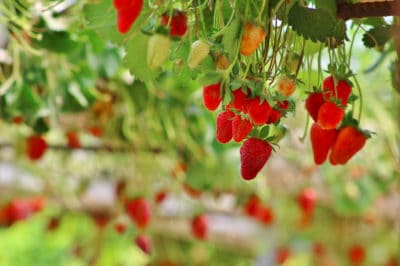Advantages
Strawberries are favored by slugs and other ground-dwelling insects. A hanging planter eliminates this problem entirely. Hanging planters take very little space, allowing you to grow some fruit in a small area. The planters can be very attractive when blooming and fruiting. Hanging planters like the upside down planter are inexpensive and can usually be reused.
Potential Problems
No planting system is perfect. Here are the disadvantages of upside-down planters:
- Plants grown upside down must first try to grow upward and then fight gravity as their fruits develop.
- Root systems are adapted to growing down, not up.
- Upside-down plants are more susceptible to disease.
- You must take extra care in watering.
- Cold weather can freeze the plants.
Commercial Planters
Commercial hanging planters are typically tubes of fabric or plastic with holes prepunched in the material. Although often referred to as upside-down planters, they are really planted along the sides as well as the bottoms. They come with chains or stout cords from which they are suspended after planting. Most can be reused for several seasons by replacing the soil each year.
Making Your Own
If you are at all handy, you can make an upside down strawberry planter. A metal or plastic bucket can provide the container. Drill several holes in the bottom. Fasten a chain to the top or use the bucket handle to hang. Make sure the hook or beam can support at least 50 pounds – wet soil is heavy. Clean the containers well before planting.
Location, Location, Location
Strawberries need full sun if possible. At a minimum, give them six hours of full sun each day. A north-facing venue is probably not going to work for these plants. Remember that water and soil will drip from the planters – either place drip trays or grow them over a washable surface. Locate them close to a water source if possible or invest in a hose that can reach the plants.
Managing an Upside Down Planter
As with any hanging planter, exposure to the wind means the soil can dry quickly. Water at least every other day and increase the frequency if the weather is hot and windy. Make sure the planter drains well. Nutrients will leach quickly with frequent watering. You should fertilize with a dilute solution of 10-10-10 liquid fertilizer once a week.
